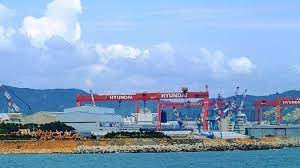The South Korean government announced plans for $2 billion in projects designed to support its shipping industry as freight rates continue to drop and there are forecasts that newbuild orders could decline dramatically in 2023. The moves come just weeks after the government announced it would invest to help develop new technologies for shipbuilding as well as changes policies to address the growing labor shortage.

According to reports in the South Korean media, the government wants to take steps to support the industry to lessen the chances of another crisis similar to the mid-2010s when rates dropped suddenly. Hanjin Shipping, which was one of South Korea’s largest carriers ranking sixth in market share for Asia-North America shipping routes, was sent into a steep decline. The company with $5 billion in debt turned to its creditors and the courts but was ultimately placed into bankruptcy and liquidation in early 2017. At the same time, Hyundai Merchant Marine sought court protection and was bailed out by the Korean Development Bank. KDB remains a large investor in the rebranded HMM.
The government’s new plan seeks to use the dividends from HMM that came from the strong surge in the market over the past two years to help finance efforts to reduce the pressures, especially on small to mid-sized carriers. The government will launch a series of new programs including its own index for freight rates.
One of the key initiatives calls for more than $700 million to be used to help the smaller carriers restructure. Another $215 million in direct aid will be made available to the cash-strapped companies. Also, to support the smaller carriers, including on domestic routes, as well as the shipbuilding industry, the Korea Ocean Business Corp. plans to invest $1.2 billion for as many as 50 vessels by 2026. They would be made available for charters by primarily domestic shipping companies. It will ensure capacity as well as provide further work to the shipbuilders that are worried that after years of record orders their business might slow due to the global economy.
To support the carriers and ensure a steady supply of capacity for the country’s small to medium-sized exporters, the Korea International Trade Association will also work with HMM to develop long-term shipping contracts.
Read Also: VESSELS EXPECTED AT LAGOS PORT AS AT WEDNESDAY 9, NOVEMBER 2022
The government also plans to closely monitor the health of the industry by launching a Korea-centric index for freight rates. The Shanghai Index doesn’t adequately reflect local conditions, the ministry said. The Korea Ocean Business Corporation reports it began work on the index to be called the Korea Container Composite Index (KKCI) over two years ago during the supply chain disruptions caused by the pandemic. The KCCI is based on cargo rates on 13 routes from Busan, South Korea’s largest port, to Asia, North America, and Europe. The index utilizes freight rates reported by the carriers and logistics companies to the Ministry of Oceans and Fisheries.
The ministry said that it believes there is no immediate risk to the carriers. They pointed to the strong profits generated for nearly three years but at the same time said economic uncertainties warranted the steps.
In October, the government said it would also invest $100 million in new technologies for the shipbuilders. The goal is to support the development of eco-friendly and automation technologies for ships as well as new techniques to improve the productivity of the shipyards. They also pledged additional support for vocational training programs and a relaxing of visa programs to assist in attracting skilled workers. By mid-2023, it was estimated that the shipbuilders could be short as many as 10,000 workers.
Kindly like us on Facebook/twitter















